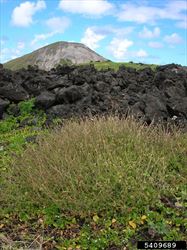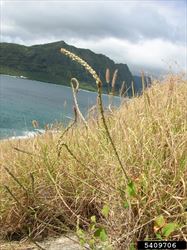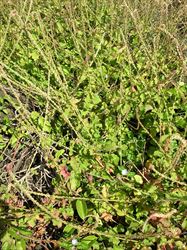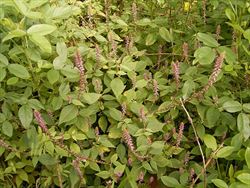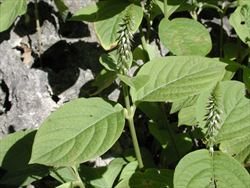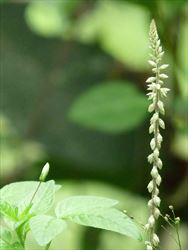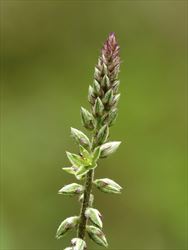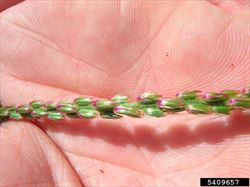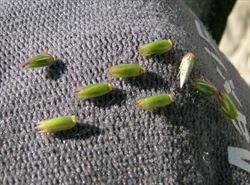- Widespread. In Australia and most Pacific island countries.
- Annual, often perennial, invasive weed found in many habitats - disturbed and cultivated land, grasslands, woodlands, forest margins, coastal areas, along roadsides, and fences. Weed of cotton, legumes, pastures, wheat; sometimes, an escape from gardens.
- Stems, up to 2m (occasionally tree-like), branched, hairy, squarish, becoming woody. Leaves, oval, up to 10cm, pointed at both ends, short stalks, hairy. Flowers, on erect spike up to 60cm, individually small, with five white, pink or greenish petal-like structures, and leaf-like bracts below. Bracts develop pointed tips.
- Spread: spines of bracts attach to animal fur, feathers, clothes. Sent internationally for use in traditional medicines.
- Biosecurity: risk is unofficial introduction of seed and plants.Available on Internet. Seeds (fruits) spiny, easily transported on animals/people/vehicles. Declared noxious weed in South Africa.
- Biocontrol: none.
- Cultural control: hand-weed or slashing; mulch (5-10cm) to prevent seedling growth; clean soil and seeds from machinery/vehicles; check clothing.
- Chemical control: in Fiji, glyphosate, 2,4-D, MCPA.
Pacific Pests, Pathogens and Weeds - Online edition
Pacific Pests, Pathogens, Weeds & Pesticides
Devil's horse whip (512)
Devil's horsewhip; it is also known as burweed, prickly chaff flower, rough chaff flower.
Achyranthes aspera. It is a member of the Amaranthaceae.
AUTHORS Grahame Jackson & Makereta Ranadi
Information from Achyranthes aspera (Devil's Horsewhip). BioNET-EAFRINET. (https://keys.lucidcentral.org/keys/v3/eafrinet/weeds/key/weeds/Media/Html/Achyranthes_aspera_(Devils_Horsewhip).htm); and CABI Achyranthes aspera (devil's horsewhip) (2021) Crop Protection Compendium. (https://www.cabi.org/cpc/datasheet/2664); and Achyranthes aspera L., Amaranthaceae. Pacific island ecosystems at risk (PIER). (http://www.hear.org/pier/species/achyranthes_aspera.htm); Achyranthes asoera (2021) Wikipedia. (https://en.wikipedia.org/wiki/Achyranthes_aspera); and from Fern K (2021) Cleome viscosa L. Tropical Plants Database. (https://tropical.theferns.info/viewtropical.php?id=Achyranthes+aspera). Photos 1-4 Forest and Kim Starr. Starr Environmental. Bugwood.org. Photo 5 Frank Vincentz (2008) Achyranthes aspera. Growing in Puntallana, La Palma, Canary Islands. (https://commons.wikimedia.org/wiki/File:Achyranthes_aspera_(Puntallana)_01_ies.jpg). Photos 6&7 Gerald McCormack. Cook Islands Biodiversity. (http://cookislands.bishopmuseum.org/results.asp?ebg=achyranthes&Submit=Search&search=true). (Photos 8&9 Jee & Rani (2010 ) Nature Photography. Creative Commons Attribution-ShareAlike 4.0 International License. Wikimedia Commons. (https://commons.wikimedia.org/wiki/File:Achyranthes_aspera_at_Kadavoor.jpg). Photos 10&11 Forrest and Kim Starr (2013) Seedhead & Spiny seeds stuck to gloves (respectively). (https://www.flickr.com/search/?text=Achyranthes%20aspera).
Produced with support from the Australian Centre for International Agricultural Research under project HORT/2016/185: Responding to emerging pest and disease threats to horticulture in the Pacific islands, implemented by the University of Queensland, in association with the Pacific Community and Koronivia Research Station, Ministry of Agriculture, Fiji.
